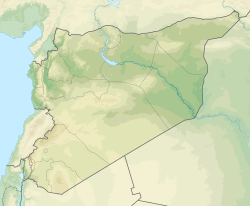Arpad, Syria facts for kids
| Location | Syria |
|---|---|
| Region | Aleppo Governorate |
| Coordinates | 36°28′N 37°06′E / 36.47°N 37.10°E |
Arpad (Old Aramaic: 𐡀𐡓𐡐𐡃, romanized: ʾRPD; Biblical Hebrew: אַרְפַּד, romanized: ʾArpaḏ or אַרְפָּד, ʾArpāḏ) was an ancient city in what is now northern Syria. Today, its remains are likely found at Tell Rifaat. Arpad was a major city for the Aramaean people. It was part of the Syro-Hittite region.
In the 800s BC, Arpad became the capital city of a powerful Aramaean kingdom called Bit Agusi. This kingdom was founded by a ruler named Gusi of Yakhan. Bit Agusi was quite large. It stretched from the A'zaz area in the north to Hamath in the south.
Later, Arpad became an important city that supported the mighty Kingdom of Urartu. In 743 BC, a big war happened between Urartu and the Neo-Assyrian Empire. The Assyrian king, Tiglath-Pileser III, defeated the Urartuan army. After this victory, he decided to attack Arpad.
Tiglath-Pileser III laid siege to Arpad. A siege means an army surrounds a city to cut off supplies and force it to surrender. Arpad was a very strong city. It did not give up easily. It took the Assyrian king three long years to finally conquer Arpad. After its capture, the city was badly damaged. Many people suffered greatly. Arpad then became a capital city for an Assyrian province. The ancient walls of Tell Rifaat, which is thought to be Arpad, are still standing up to eight meters high today.
What Does the Name Arpad Mean?
The name Arpad has interesting meanings. In Hebrew, it can mean 'the light of redemption'. It can also mean 'I shall be spread out' or 'I shall be supported'.
Exploring Arpad: Archaeology
The ancient site of Tell Rifaat, believed to be Arpad, is shaped like an oval. It measures about 250 meters by 233 meters. Inside this area, there is a main citadel, which is like a strong fortress. This citadel is 142 meters by 142 meters. It rises to a height of 30 meters. A large defensive wall surrounds the entire site. This wall is about two miles long.
Archaeologists have worked at this site. A team from the Institute of Archaeology at the University of London studied Tell Rifa'at. They first looked at the site in 1956. Then, they dug there for two seasons, in 1961 and 1964. The team was led by a person named Veronica Seton-Williams.
In 1977, another archaeological study was done. This time, the Institute of Archaeology surveyed the area all around Tell Rifa'at.
See also


